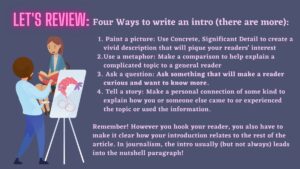More time to “tidy up” your Unit Two article. You will definitely want to make sure you have a compelling intro that hooks the reader. Click on the image above to get to the slideshow we watched in class on Tuesday for help in writing intros and linking them to the nutshell paragraph.
You can update your Unit Two Final draft by simply clicking “edit” at the bottom of the blog post (info how to do this HERE)– or you can resubmit a new Word or PDF doc. (Please make sure you are using the category: Unit 2 Final Draft. Otherwise your paper might get lost!)
You will also want to proofread and check your citations. I suggest the following steps:
- Write a new introduction, using the slideshow as your guide. You might try a couple of these intro strategies and pick the one you like best. You’re welcome to keep the intro you already have if you prefer, but make sure you have one!
- Go through your essay and proofread it. By this, I mean, look for sentence-level issues. If you know you have a problem with run-ons, look for ONLY that issue. (And run spell-check!)
- After you have proofread once, read your essay out loud! Really! Do it with a pen or pencil in your hand and mark sentences that sound strange. Go back and fix them! Take out words that sound extra or “fluffy” (meaning they are just there to add to the word count.) The word count is there so your article has enough meaning, not so it has just a bunch of words! At this point, forget about the word count. Just make it sound good and mean something.
- Now, go back and make sure you have done your citations. Remember, you may either hyperlink or use MLA.
- Make sure you have done a bibliography. I suggest using Easybib.com
- If you want, add a few images– or a better title. Think about the things that draw you to an article when you’re reading.





Recent Comments